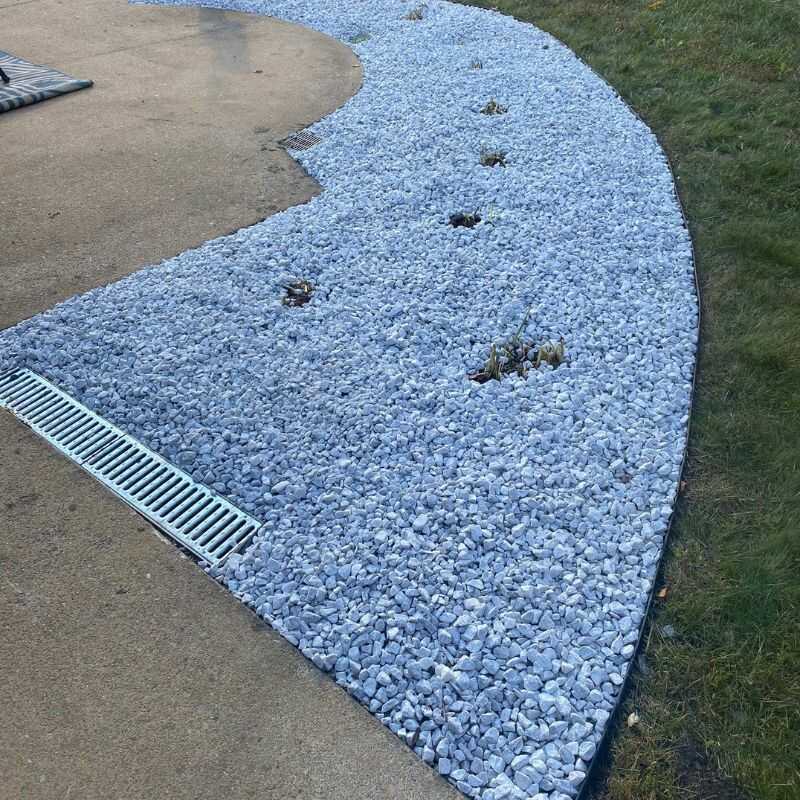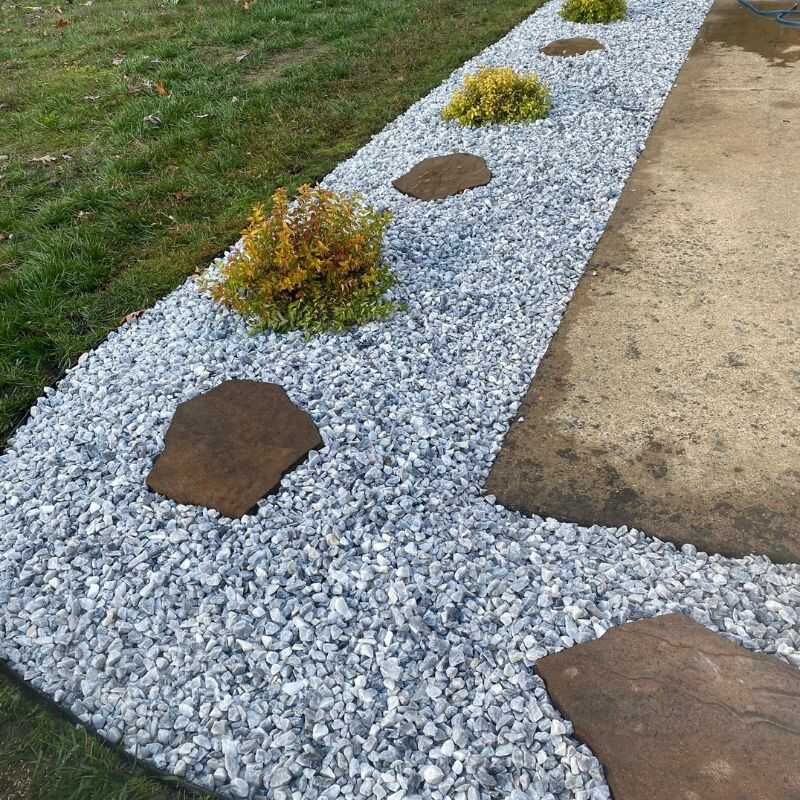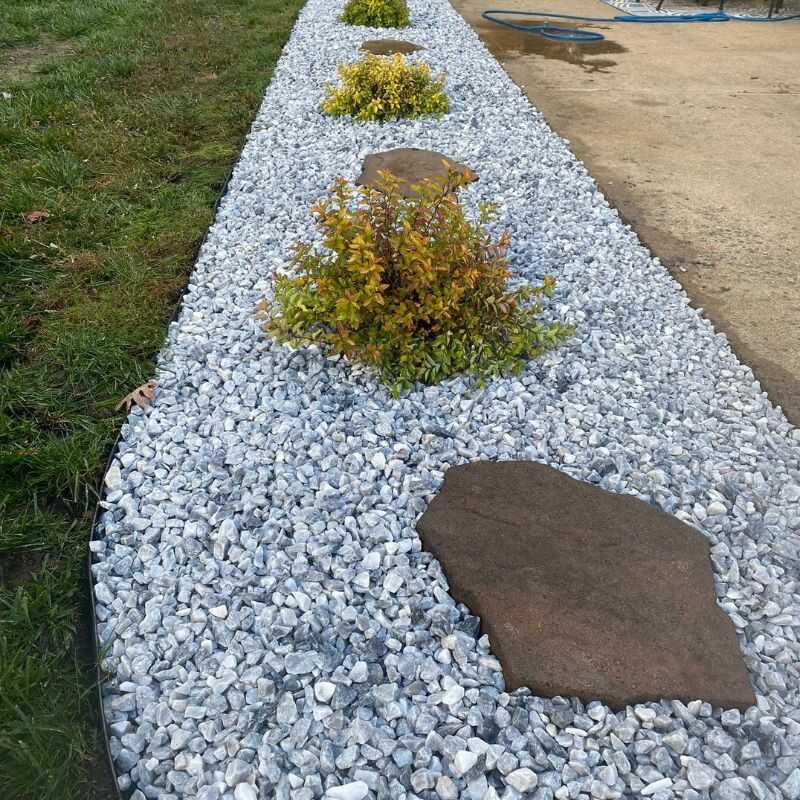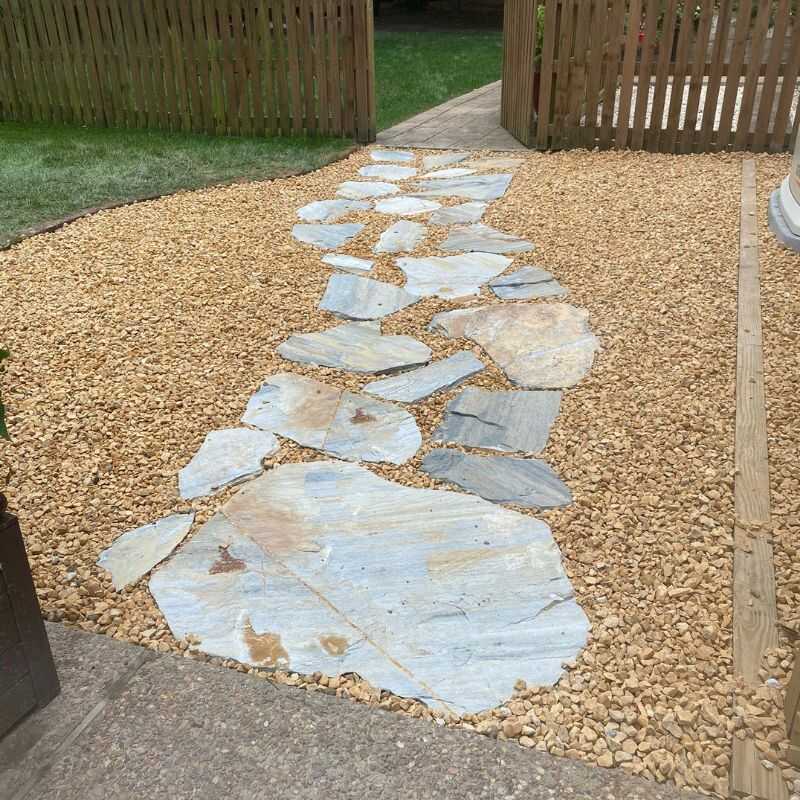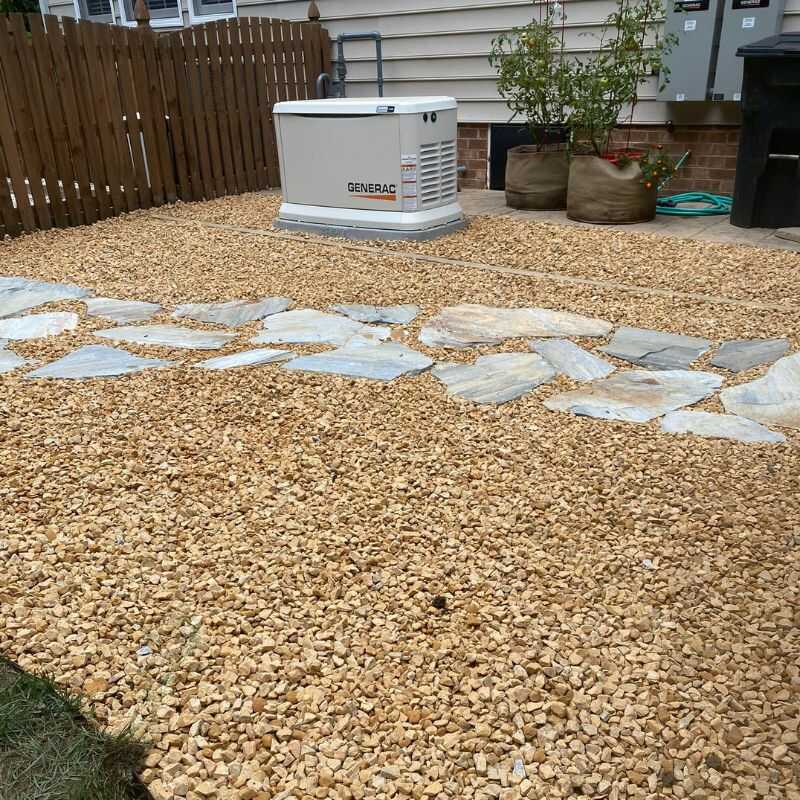Durability in hardscaping isn’t optional—it’s a must. Selecting the right materials ensures your patio, walkway, or retaining wall will stand the test of time, resist weather, and maintain its appearance with minimal maintenance.
Hardscaping Solutions for Walkways, Patios & Retaining Walls
What Is Hardscaping and Why It Matters in Richmond, VA
Hardscaping is more than just a design choice—it’s a strategic investment in both the appearance and function of your property. In Richmond, VA, where seasonal changes and sloped terrain are common, a thoughtful hardscaping plan helps homeowners create usable outdoor areas while protecting against erosion, flooding, and wear.
By incorporating structures like patios, walkways, and retaining walls, hardscaping delivers both immediate curb appeal and long-term durability. Whether you want to host backyard barbecues, add structured beauty, or reduce the need for weekly yard work, well-built hardscapes deliver measurable value.
Defining Hardscaping vs Landscaping
Let’s begin by distinguishing hardscaping from landscaping.
Hardscaping refers to all the non-living elements in your outdoor environment—pavers, stone walkways, wood decks, retaining walls, concrete stairs, and more.
In contrast, landscaping includes the living, organic components: plants, flowers, grass, and shrubs.
Why does this matter? Hardscaping creates the framework that landscaping fills in. Without solid groundwork like patios and paths, gardens often struggle with runoff, compaction, and disorganization.
Functional Advantages of Hardscaping
Next, let’s explore how hardscaping makes outdoor spaces more functional.
Improves access and navigation: Walkways and stepping stones prevent muddy shoes and trampled grass.
Controls slope and erosion: Retaining walls hold soil in place and prevent water from washing out your flower beds.
Defines zones: Create designated spaces for grilling, gardening, playing, or lounging.
Especially in Richmond neighborhoods with sloped lots and dense clay soils, hardscaping helps maintain structural integrity and prevents costly maintenance down the road.
Aesthetic and Property Value Benefits
Hardscaping also contributes immensely to your home’s visual appeal and market value.
Materials like natural stone or decorative concrete elevate the visual richness of your property.
Seamless transitions from patio to garden create a professional, polished look.
Well-designed hardscaping adds $5,000–$15,000 in appraised home value according to NAR studies.
In historic Richmond districts, many homeowners are revitalizing older properties with classic pavers, stacked stone walls, and brick-lined paths.
Climate-Smart Designs for Richmond, VA
Finally, let’s talk about climate resilience. Richmond weather includes scorching summers, heavy rain in spring, and freeze-thaw cycles during winter. A good hardscape design adapts to all of this:
Permeable pavers allow water to drain naturally, avoiding pooling or flooding.
Expansion joints and frost-resistant materials prevent cracks.
Drainage systems and slope grading move water away from your foundation.
These aren’t luxuries—they’re essentials for homeowners who want long-term performance without seasonal headaches.
🔗 American Society of Landscape Architects: Climate-Resilient Hardscaping
The Value of Hardscaping
| Category | Functionality Provided | Why It Matters in Richmond, VA |
|---|---|---|
| Foundation & Structure | Organizes space, prevents erosion | Richmond clay soil & rainfall create runoff challenges |
| Accessibility | Safe, clean paths and zones | Prevents slips, mud, and lawn compaction |
| Visual Appeal | Adds polish, symmetry, and modern elegance | Raises curb appeal in historic and modern neighborhoods |
| Home Value | Increases appraised property worth | Enhances ROI in competitive real estate markets |
| Durability | Withstands climate stress and seasonal shifts | Freeze-thaw and storms are common |
A professionally designed hardscaping system delivers more than beauty. It creates livable outdoor spaces, protects your investment, and stands up to Virginia’s diverse climate. Whether you’re adding a pathway, building a retaining wall, or expanding a patio, proper hardscaping ensures your outdoor space functions beautifully—year after year.
Core Elements of Hardscaping: Walkways, Patios & Retaining Walls
Hardscaping—as we define it at JJ & R Landscaping—is the backbone of a structured, attractive, and long-lasting outdoor environment. Across Richmond, VA, our projects center on the three key pillars: walkways, patios, and retaining walls. Each serves distinct functions but together form a cohesive landscape that marries beauty with purpose
Walkways: Defining Pathways That Perform & Impress
Walkways are the circulatory system of your yard, guiding foot traffic and protecting your garden. In Richmond’s shady, damp climate, a well-designed walkway prevents soil compaction and grass damage. Here’s why they’re essential:
Protect Turf & Soil: Well-built stone or paver paths shield grass from heavy foot traffic, especially during rainy seasons.
Add Visual Direction: Meandering walkways create visual interest, invite movement, and accent landscaping features.
Prevent Mud Buildup: Crushed stone or permeable pavers reduce pooling and keep your yard clean and tidy.
Patios: Outdoor Rooms Crafted for Enjoyment
A quality patio isn’t just aesthetic—it’s a year-round extension of your home. In Richmond, where summers are humid and winters mild, patios become entertaining hubs:
Social Hub Creation: Properly sized patios accommodate furniture, cooking areas, and social gatherings.
Material Harmony: Choices like flagstone, stamped concrete, or brick complement regional architectural styles.
Water Management Built-In: Correct patio slope—usually 1/8–1/4″ per foot—ensures rainwater flows away from your home.
Retaining Walls: Structural Support Meets Aesthetic Appeal
Retaining walls do more than hold back soil—they sculpt landscapes, prevent erosion, and create usable terraces:
Slope Stabilization: In neighborhoods with steep grades, walls prevent soil erosion and safeguard plants.
Multi-Level Yards: Terraced walls create usable levels for gardens, sitting areas, or fire pits.
Durable Construction: We use reinforced block, natural stone, and proper drainage systems to prevent bulging or collapse.
Integrated Hardscape Systems: A Seamless Outdoor Experience
When walkways, patios, and walls are designed in unison, your yard transforms into a seamless environment:
Flow & Connectivity: Walkways connect patios and seating areas, creating intuitive navigation.
Material Coordination: Matching stone, mortar color, and joint pattern delivers visual continuity.
Tiered Landscaping: Walls create planting pockets and natural division of space.
Evaluating Key Hardscape Features
| Element | Primary Benefits | Richmond Advantage |
|---|---|---|
| Walkways | Direct traffic, protect turf, define garden paths | Tackles muddy conditions; enhances yard navigation |
| Patios | Living space, outdoor entertaining, aesthetic upgrade | Suits regional weather; easy drainage |
| Retaining Walls | Soil control, slope use, landscaping structure | Stabilizes hillside lots; adds tiered garden functionality |
| Integrated Design | Fluid spaces, unified look, functional zoning | Elevates overall landscape quality and usability |
Richmond homeowners need hardscape elements that don’t just look good—they must perform through seasonal changes and heavy use. By carefully designing walkways, patios, and retaining walls—and integrating them seamlessly—we sculpt outdoor spaces that endure and delight for years to come.
Hardscaping Materials: Choosing Pavers, Stone, and Concrete for Durability
Hardscaping materials define both the function and long-term resilience of your outdoor space. Selecting the right stone, paver, or concrete option is crucial—especially in Richmond’s freeze-thaw climate and heavy clay soil. Below is a refined examination of optimal materials paired with practical considerations.
Natural Stone: Timeless Beauty with High Durability
Natural stone—such as flagstone, bluestone, or fieldstone—offers organic charm and excellent longevity. In addition:
Unmatched Aesthetic: Each slab varies naturally, creating unique textures and rich tones.
Heavy-Duty Performance: Resistant to cracking under heavy load; ideal for patios and walkways.
Ease of Replacement: Individual stones can be lifted and replaced without disturbing surrounding areas.
Concrete Pavers: Versatile and Cost-Effective
Concrete pavers come in countless shapes, sizes, and colors. They’re:
Extremely Customizable: Ideal for designing intricate patterns or matching specific aesthetics.
Performance-Oriented: Engineered for interlocking stability, strength, and ease of repair.
Freeze-Thaw Resistant: Quality pavers handle Richmond’s seasonal cycles effectively when properly installed.
Porcelain & Composite Slabs: The Modern Alternative
Modern materials like porcelain or engineered stone offer sleek appeal and practical benefits:
Low Maintenance: Impervious to staining and easy to clean.
Uniform Aesthetics: Sheets provide consistent coloring and pattern control.
Eco-Conscious Choices: Some are made from recycled materials and deploy in permeable systems.
Natural vs Manufactured Retaining Wall Units
Choosing between natural stone and engineered retaining units involves weighing pros and cons:
Natural stone offers organic charm but often requires more labor and mortar.
Engineered blocks provide consistent sizing and simpler installation with dry-stacked interlocking systems.
Drainage considerations apply to both; however, block systems often include built-in gravel and weep systems for water flow control.
🔗 International Masonry Institute: Retaining Wall Best Practices
Materials Comparison
| Material Type | Aesthetic Appeal | Durability | Maintenance / Repair Ease |
|---|---|---|---|
| Natural Stone | High-end, organic beauty | Excellent; heavy-duty | Stones can be individually replaced |
| Concrete Pavers | Highly customizable | Engineered for heavy loads | Easy to repair; interlocking stability |
| Porcelain/Composite | Sleek, modern look | Durable and stain-resistant | Minimal maintenance required |
| Engineered Retaining Blocks | Neat, consistent appearance | Up to 6 ft high structurally solid | Replaceable blocks; built-in drainage |
Choosing the proper hardscaping materials is equal parts aesthetic and technical decision. Richmond’s climate demands tear-resistant, frost-proof solutions—whether using natural stone’s timeless elegance or engineered pavers’ performance. JJ & R Landscaping prioritizes both style and substance, delivering durable outdoor structures that thrive through Virginia’s seasonal challenges.
Hardscaping Design Tips for Walkways, Patios & Walls
Hardscaping design isn’t only about selecting materials—it’s about spatial harmony, functional flow, and aesthetic coherence. Especially in Richmond, VA, thoughtful design ensures outdoor spaces withstand seasonal rain, uneven terrain, and heavy usage. In this section, we explore pro-level design strategies that elevate your outdoor environment.
Site Analysis & Functional Zoning
Before any hardscape work begins, we analyze your property—slope, sunlight, usage patterns, and landscape features. This step is crucial:
Identify natural pathways for foot traffic to place walkways efficiently.
Define zones for cooking, relaxing, and planting.
Account for elevation changes to determine retaining wall placement and patio grading.
Contextual design saves money later by reducing rework and improving usability.
Scale & Proportions for Cohesive Layouts
Matching scale ensures balanced outdoor spaces:
Choose patio sizes that accommodate furniture while maintaining intimacy.
Design walkways around 3–5 feet wide for easy two-person walking.
Tailor wall height and thickness to match yard gradient and visual weight.
Proper proportions also help the design fit the architectural style of your home.
Material Coordination & Color Palettes
Mixing materials is a delicate balance:
Use complementary stone and joint materials for harmony.
Incorporate accents—like metal edging or lighting—to tie zones together.
Choose colors that complement house siding, brick, or roof tones.
A unified palette enhances visual continuity and property appeal.
Blending Indoor-Outdoor Flow
To extend living space outdoors seamlessly:
Align patio surfaces flush with main floor exits.
Install gradual surface transitions to prevent trip hazards.
Use consistent paving materials or steps to visually connect areas.
This continuity encourages regular outdoor use and makes spaces feel larger.
Lighting & Landscape Integration
Effective lighting and plant accents complete the design:
Path lights, uplights, and accent lighting enhance safety and ambiance.
Landscape plants soften hard edges and create natural borders.
Choose native plantings to reduce maintenance and support local ecology.
Lighting combined with landscaping brings hardscapes to life—especially at dusk.
Pro Design Principles
| Design Element | Benefit | Richmond Advantage |
|---|---|---|
| Site & Function Analysis | Determines layout, slopes, zone placement | Adapts to local terrain and usage patterns |
| Scale & Proportion | Creates spaces that feel right | Ensures walkways and patios don’t overwhelm yard |
| Material Coordination | Achieves aesthetic harmony | Matches local architecture and vegetation |
| Indoor–Outdoor Flow | Enhances accessibility | Promotes daily usage and property enjoyment |
| Lighting & Landscape | Adds safety and ambiance | Boosts curb appeal during evening hours |
A successful hardscaping design balances form and function—it’s responsive to site conditions, purposeful in layout, and consistent in materials. In Richmond’s varied terrain and seasonal weather, these design strategies ensure outdoor spaces remain beautiful, usable, and sturdy for years to come.
Building with Precision: Hardscaping Installation Best Practices
Mastering hardscaping installation means more than laying stones — it’s an artful process that balances engineering, drainage, and design to guarantee long-term beauty and structural integrity. From the foundation to final sealing, each phase affects performance and durability.
Sub-Base Preparation: The Strength Below
Every professional hardscape begins with a properly compacted sub-base. Skipping this step is one of the biggest reasons for uneven surfaces, shifting pavers, or water pooling.
Excavate to the appropriate depth depending on the structure (typically 4–12 inches).
Use a crushed stone or gravel base compacted in layers for optimal load distribution.
Include a geotextile fabric barrier to block weeds and stabilize the soil.
The right base prevents cracking, sagging, and drainage problems later on.
Drainage Design: Directing Water the Smart Way
In hardscaping, water management is key to long-term success. Without strategic drainage, patios and walkways deteriorate quickly from water damage.
Slope surfaces at least 2% away from the house to direct runoff.
Use permeable pavers or install French drains in problem areas.
Prevent puddling near borders or retaining walls by adding catch basins or gravel trenches.
A dry, stable base is what keeps your project intact through Virginia’s wet seasons.
Precision Stone Laying: Details Make the Difference
Aligning stones or pavers isn’t just cosmetic—it affects structural strength and walkability. Proper layout and spacing help reduce future repairs.
Start from a corner or centerline using string guides and a rubber mallet.
Maintain consistent joint spacing and avoid lippage (uneven height between stones).
Sweep in polymeric sand or seal the joints for extra weed and water resistance.
This phase brings the vision to life while locking your investment into place.
Finishing Touches: Sealers, Borders & Clean Edges
Once the hardscape is installed, the final details protect your work and elevate the overall aesthetic. Sealing is crucial for longevity, while clean borders define the space.
Apply UV-resistant sealers to prevent stains and color fading.
Use border stones, steel edging, or gravel accents for a polished look.
Consider integrating lighting or planting beds for a functional, cohesive design.
These elements enhance usability and add curb appeal, especially when blended with existing landscaping.
Hardscaping Installation Essentials
| Step | Key Action | Benefit |
|---|---|---|
| Sub-Base Preparation | Excavate & compact gravel in layers | Prevents sinking & cracking |
| Drainage Design | Slope surfaces & install drains | Protects against water damage |
| Stone Laying | Align precisely, seal joints | Ensures durability & stability |
| Finishing Touches | Apply sealers, add clean borders | Boosts longevity & aesthetics |
Choosing the Right Hardscaping Materials for Durability and Design
When designing a long-lasting and visually pleasing hardscaping project, material selection plays a pivotal role. From functionality to aesthetics, every element—stone, concrete, brick, or wood—affects maintenance, climate resilience, and curb appeal.
Concrete Pavers: Versatility Meets Affordability
Concrete pavers are a popular choice for patios, walkways, and driveways due to their adaptability and cost-effectiveness. They are available in various textures, colors, and shapes.
Durable and ideal for high-traffic areas like driveways.
Can be easily replaced if damaged, unlike poured concrete.
Slip-resistant textures available for safety around pools.
Their flexibility makes them perfect for custom designs while staying within budget.
Natural Stone: Timeless Beauty with Premium Durability
For a premium look, nothing beats the organic texture of natural stone. Materials like bluestone, flagstone, and slate provide unmatched character and lasting strength.
Each stone is unique, adding natural elegance to the space.
Weather-resistant and suitable for various climates.
Requires professional installation due to weight and irregular shapes.
Though costlier, natural stone enhances property value and requires minimal maintenance.
Brick & Clay: Classic Charm for Traditional Settings
Brick is ideal for those seeking a warm, traditional aesthetic. It’s especially fitting for historic homes or gardens with classic landscaping.
High compressive strength—great for walkways or borders.
Fade-resistant and retains color for decades.
Easily laid in herringbone or basket-weave patterns for extra charm.
Brick can be mixed with other materials for a timeless yet customized style.
Composite & Recycled Materials: Sustainable Alternatives
Eco-conscious homeowners can now enjoy sustainable hardscaping through innovative materials like recycled rubber pavers and composite decking stones.
Made from recycled tires, plastics, and resins.
Lightweight and easy to install.
Often resistant to cracking, mold, and UV rays.
These materials reduce environmental impact while maintaining structural integrity.
Hardscaping Material Options
| Material Type | Key Features | Best Use Cases |
|---|---|---|
| Concrete Pavers | Affordable, replaceable, slip-resistant | Patios, walkways, driveways |
| Natural Stone | Premium look, highly durable | High-end landscapes, patios |
| Brick & Clay | Classic style, color retention | Garden paths, borders, porches |
| Recycled Materials | Sustainable, easy to maintain | Eco-projects, light-traffic zones |
Hardscaping for Sloped Landscapes and Elevation Challenges
Hardscaping on uneven or sloped terrain requires specialized design strategies. It’s not just about aesthetic improvement—it’s about managing erosion, improving usability, and enhancing structural stability.
Retaining Walls: Structure Meets Style
Retaining walls are essential in hardscaping projects on slopes, as they prevent soil erosion and create level planting areas or patio zones.
Anchor outdoor spaces securely with structural integrity.
Add terraced levels for increased functionality.
Available in stone, concrete blocks, or modular systems.
A well-constructed retaining wall also doubles as a decorative focal point.
Tiered Levels: Divide Space with Purpose
Instead of fighting a slope, embrace it by creating multiple levels or zones.
Allocate one level for lounging and another for gardening.
Use steps, pavers, or boulder arrangements for transitions.
Enhance each level with lighting or planters for depth.
Tiered hardscapes make the most of vertical space and increase accessibility.
Drainage Solutions: Function First
Slope control is only effective if water runoff is addressed. Good drainage must go hand in hand with any hardscaping structure.
Install French drains or permeable pavers to manage flow.
Grade surfaces away from structures and seating areas.
Use gravel beds and landscape fabric under patios for filtration.
Proper drainage protects your investment and avoids foundational damage.
Steps and Sloped Walkways: Blending Access with Design
Steps and walkways on an incline should feel effortless and look intentional.
Use natural stone or precast concrete for tread consistency.
Incorporate handrails or low risers for safety.
Add path lighting to ensure evening visibility.
Smooth navigation on sloped hardscapes boosts functionality and beauty.
Summary Table: Hardscaping on Slopes
| Element | Purpose | Recommended Materials |
|---|---|---|
| Retaining Walls | Erosion control, create flat zones | Natural stone, concrete block |
| Tiered Levels | Space organization, visual layering | Stone risers, timber, boulders |
| Drainage Systems | Prevent water pooling and soil washout | Permeable pavers, gravel, drains |
| Sloped Walkways | Safe and stylish elevation transition | Flagstone, concrete, composite |
Choosing the Right Materials for Durable Hardscaping Projects
Concrete Pavers: Cost-Efficient and Customizable
Concrete pavers are among the most popular hardscaping choices due to their affordability, versatility, and availability in multiple shapes and finishes.
Offer excellent load-bearing strength.
Interlock for enhanced stability and easy repairs.
Come in various textures that mimic natural stone.
These are ideal for driveways, patios, and walkways in residential or commercial applications.
Natural Stone: Timeless, Elegant, and Enduring
When visual appeal is a priority, natural stone brings unmatched texture and depth.
Slate, flagstone, limestone, and granite are top choices.
Each stone piece is unique, offering natural variation.
Requires professional installation due to irregular shapes.
Though more expensive, natural stone adds value and prestige to any landscape.
Gravel and Crushed Stone: Budget-Friendly and Permeable
Perfect for informal pathways and rustic garden features, gravel is a flexible and eco-friendly choice.
Allows water permeability, helping with drainage.
Easy to install and replace.
Can be used as a base layer or top surfacing.
Pairing gravel with edging or stepping stones keeps areas tidy and navigable.
Brick and Recycled Materials: Sustainable and Charming
Recycled brick and eco-friendly composite materials add character and reduce environmental impact.
Ideal for vintage or historic home exteriors.
Reclaimed bricks bring rich tones and textures.
Composite pavers made from rubber or plastics are lightweight and mold-resistant.
These alternatives blend green building with aesthetic variety.
🔗 Sustainable Hardscape Materials – Green Building Solutions
Summary Table: Material Options in Hardscaping
| Material Type | Key Benefits | Ideal Applications |
|---|---|---|
| Concrete Pavers 🧱 | Durable, customizable, affordable ⚙️ | Patios, walkways, driveways 🚶♂️ |
| Natural Stone 🪨 | Luxurious look, highly durable 💎 | High-end patios, retaining walls 🏛️ |
| Gravel & Crushed Stone 🌫️ | Drainage-friendly, low cost 💧 | Garden paths, casual walkways 🌿 |
| Recycled Brick/Composite ♻️ | Eco-conscious, historic charm 🏡 | Borders, patios, green projects 🌱 |
Proper Installation Techniques for Long-Lasting Hardscaping
In hardscaping, even the most expensive materials can fail if not installed correctly. Whether you’re building a walkway, a patio, or decorative borders, technique is everything. Proper ground preparation, edge reinforcement, drainage solutions, and compacting layers define the durability and visual integrity of any hardscaping element. Without attention to detail in these areas, the structure may crack, shift, or settle unevenly. Below, we explore four critical aspects of professional-grade hardscaping installation that every homeowner in Richmond, VA should understand before hiring a contractor.
Subbase Preparation: Start with a Solid Foundation
The first and most overlooked step in hardscaping is preparing a reliable subbase.
A compacted gravel layer (minimum 4–6 inches) is essential.
Use crushed stone that compacts well to prevent shifting.
Avoid using loose soil, which settles over time.
Proper subbase prep ensures the longevity and stability of the surface, especially in high-traffic areas.
Edge Restraints: Preventing Lateral Movement
Without secure edge restraints, your pavers or stones will migrate and loosen over time.
Install heavy-duty plastic or aluminum edging.
Spike them deep enough to prevent movement.
Ideal for patios, borders, and curved pathways.
This ensures clean, straight lines and helps maintain pattern integrity for years.
Proper Layering and Compaction: No Skipping Steps
Every layer—from gravel to sand to pavers—must be compacted thoroughly.
Use a vibrating plate compactor after each layer.
Check for evenness with a level tool.
Compact again after final installation to lock the surface.
Skipping compaction leads to sunken areas, uneven surfaces, and weed growth.
Drainage Considerations: Keeping Water Flowing
Poor drainage leads to erosion, standing water, and premature failure of your hardscape.
Slight slopes (1/8 inch per foot) direct water away.
Use perforated pipes or French drains beneath if necessary.
Consider permeable pavers for added protection.
This is especially vital in Virginia’s fluctuating climate.
Summary Table: Key Installation Practices for Hardscaping
| Installation Element | Description & Importance | Common Use Cases |
|---|---|---|
| Subbase Preparation 🛠️ | Creates a stable foundation 🧱 | All hardscape areas 🏡 |
| Edge Restraints 📏 | Prevents paver movement 🚧 | Walkways, patios, borders 🚶♂️ |
| Layering & Compaction 📐 | Enhances durability, prevents sinking 💪 | Patios, driveways 🚗 |
| Drainage Implementation 💧 | Prevents erosion and standing water 🌧️ | All outdoor surfaces 🌿 |
Hardscaping success depends more on what lies beneath the surface than what meets the eye. By ensuring correct installation techniques, homeowners protect their investment and avoid costly future repairs. Whether you’re creating a cozy patio or a formal walkway, always work with professionals who understand the science behind the beauty.
Maintenance Strategies to Preserve Your Hardscaping Investment
A beautifully installed hardscape can degrade rapidly if not properly maintained. That’s why maintenance isn’t optional—it’s essential. Hardscaping materials face natural wear from foot traffic, seasonal weather fluctuations, UV exposure, and soil movement. In Richmond, VA, the combination of humid summers, freeze-thaw winters, and heavy rain demands a proactive maintenance plan. This section explores four key strategies to prolong the lifespan of patios, walkways, retaining walls, and other hardscaping features.
Regular Cleaning: Keep Surfaces Looking New
Dirt, debris, and organic buildup can discolor surfaces and degrade joint integrity over time.
Sweep surfaces weekly to prevent debris accumulation.
Use mild detergent and water for stained areas; avoid harsh chemicals.
Apply a low-pressure power wash annually for deep cleaning.
Consistent cleaning protects materials and keeps your hardscape visually appealing year-round.
Sealer Reapplication: Maintain Color & Protection
Sealant protects pavers and stone from stains, UV damage, and water infiltration.
Inspect sealant annually; a lack of bead formation indicates it’s time to reseal.
Use high-quality, UV-resistant sealers appropriate for your material.
Proper prep—cleaning, drying—is essential before reapplication.
A fresh coat of sealant enhances appearance and extends the material’s lifespan.
Joint Care: Prevent Weed Growth & Stabilize Pavers
Joint compounds can erode, inviting weed growth or shifting pavers.
Remove weeds with a plastic scoop to avoid damaging edges.
Refill with polymeric sand or mortar as needed to maintain joint integrity.
Use preventer sprays that are safe for hardscaping to inhibit weed seeds.
Well-maintained joints mean fewer weeds and a safer, more polished surface.
Structural Inspection: Address Early Signs of Damage
Identifying minor cracks or settling early prevents extensive repairs later.
Inspect annually for cracks, pooling water, loose pieces, or mortar separation.
Re-level sunken pavers by lifting, adjusting the base, and relaying them.
Repair cracks in walls or stonework with matching mortar or sealant.
Prompt action keeps your hardscape looking great and structurally sound.
🔗 Hardscape Repair Techniques – National Concrete Masonry Association
Summary Table: Hardscape Maintenance Essentials
| Maintenance Task | Frequency & Best Practices | Why It Matters in Richmond, VA |
|---|---|---|
| Cleaning 🧼 | Weekly sweep, annual wash 🗓️ | Prevents stains and material degradation 🛡️ |
| Sealant Reapplication 🧴 | Every 2–3 years 🔁 | Maintains color, UV resistance, water protection 🌞 |
| Joint Maintenance 🧱 | As needed, typically annually 📆 | Stops weeds and stabilizes surface alignment 🌿 |
| Structural Inspection 🔍 | Annual check, immediate repairs 🛠️ | Prevents small issues from becoming costly problems 💰 |
Regular maintenance for your hardscaping ensures longevity and beauty while protecting your investment. From cleaning and resealing to joint upkeep and inspections, each task contributes to a durable, safe, and visually striking outdoor environment. For Richmond homeowners, a seasonal maintenance plan is key to keeping patios, walkways, and walls in optimal condition year after year.
Hardscaping in All Seasons: Adapt Your Approach Year-Round
When it comes to hardscaping, seasonal awareness isn’t just helpful—it’s essential. Each season brings unique challenges that can affect the appearance, durability, and functionality of your walkways, patios, and retaining structures. In Richmond, VA, the weather cycle includes intense heat, heavy rainfall, freezing winters, and high humidity. To ensure year-round performance and visual appeal of your hardscape features, seasonal adjustments in maintenance and usage are non-negotiable. Let’s dive into how each season impacts your hardscaping and what you can do to mitigate problems before they arise.
Spring: Inspect and Rejuvenate After Winter
Spring is the best time for inspecting damage caused by freeze-thaw cycles and debris accumulation.
Check for loose pavers, shifting stones, or cracks in retaining walls.
Clean thoroughly with biodegradable soap and light pressure washing.
Reapply polymeric sand to stabilize joints that eroded over winter.
Proper spring prep restores integrity and boosts curb appeal after dormant months.
🔗 Spring Landscape Tips – National Association of Landscape Professionals
Summer: Protect from Heat and Heavy Use
The heat and increased foot traffic of summer demand more attention to durability.
Water nearby plants cautiously to prevent runoff weakening hardscape edges.
Apply UV-resistant sealants to prevent color fading and material weakening.
Address any pooling issues, which can lead to algae and material deterioration.
Preventive care in summer helps avoid structural stress and cosmetic damage.
Fall: Prepare for the Cold and Leaf Accumulation
Fall is ideal for preparing your hardscape for winter’s challenges.
Remove fallen leaves promptly to prevent staining and moisture entrapment.
Repair minor cracks that may worsen during freezing temperatures.
Clean and inspect drainage systems around hardscape to ensure flow.
Fall prep increases hardscape longevity and avoids winter surprises.
Winter: Monitor and Mitigate Freeze Damage
Cold weather can damage poorly prepped hardscaping materials.
Avoid using salt-based deicers on pavers—opt for calcium magnesium acetate.
Gently remove snow with plastic shovels to prevent surface chipping.
Keep a winter inspection log to note developing cracks or dislodged elements.
Vigilance in winter ensures spring restoration is minimal and affordable.
Summary Table: Seasonal Hardscape Adaptation
| Service Paired | Benefit of Coordination | Why It Matters in Fall |
|---|---|---|
| Aeration + Overseeding🌱 | Builds soil health and turf density🪴 | Preps lawn for winter green-up❄️ |
| Fertilizing💧 | Recharges nutrients absorbed after seeding🌾 | Enhances root development🌿 |
| Mulching🍂 | Insulates and beautifies landscape beds🌸 | Protects soil and suppresses weeds🛡️ |
| Bundled Service Scheduling📋 | Simplifies planning, ensures consistency✅ | Saves time and ensures superior results⏱️ |
By aligning your hardscaping care with seasonal demands, you not only enhance functionality but also safeguard your investment. Regular adjustments based on climate ensure the longevity of patios, pathways, and walls. Seasonal hardscape management in Richmond, VA isn’t a luxury—it’s a critical step toward long-term outdoor success.
Frequently Asked Questions About Hardscaping in Richmond, VA
What exactly is hardscaping and how is it different from landscaping?
Hardscaping refers to the non-living elements of your outdoor space — like patios, stone walkways, retaining walls, and outdoor kitchens. Landscaping, in contrast, focuses on plants, trees, grass, and mulch. The best outdoor designs integrate both. Learn more via NALP.
Why should I invest in hardscaping for my home or business?
Hardscaping enhances the functionality and aesthetics of your property. It creates usable outdoor living spaces, prevents erosion with retaining walls, and adds long-term property value. For many Richmond, VA homeowners, it’s a foundational investment in curb appeal and structure. External Source: EPA.
How long does a typical hardscaping project take to complete?
Most hardscaping projects — such as patios or walkways — take between 1–3 weeks depending on design complexity, material availability, and weather conditions. JJ&R Landscaping provides a detailed project timeline during the consultation process. Book a Consultation Now →
What materials are best for durability in the Richmond, VA climate?
Richmond’s seasonal changes require durable materials. Concrete pavers, natural stone, and brick are excellent options for long-lasting hardscapes. These materials handle freeze-thaw cycles and moisture better than others. Reference: ICPI.
Can hardscaping help with drainage problems?
While JJ&R Landscaping does not offer drainage-specific services, proper hardscaping design (like sloped patios or retaining walls) can help redirect water runoff. Our team ensures water flow considerations are built into every hardscape layout. External Guide: USDA.
How do I maintain my hardscaping features year-round?
Regular cleaning, re-sealing pavers, and inspecting joints or cracks annually can preserve the look and stability of your hardscapes. We also recommend seasonal pressure washing. Maintenance Guide: ICPI.
Why Choose JJ&R Landscaping for Hardscaping in Richmond, VA
Your hardscaping project deserves a contractor that blends experience, reliability, and local expertise. JJ&R Landscaping is Richmond’s trusted partner for premium outdoor transformations—from stunning walkways and patios to engineered retaining walls. Here’s why homeowners throughout Central Virginia choose us for long-lasting and beautiful hardscape results.
✅ Specialized Hardscaping Expertise🧱
Our team focuses solely on landscaping and hardscaping, not general contracting.
- Over 18 years dedicated to outdoor design, grading, and layout
- Certified ICPI and NCMA standards
- Installations for pavers, stone, concrete, and blocks
✅ Personalized Design & Planning🧩
We don’t believe in cookie-cutter designs.
- Detailed site evaluations and 3D renderings
- Seamless integration with your current landscape
- Color/material coordination with your home
✅ Quality Materials That Last🏗️
Only premium, weather-resistant, and eco-friendly materials are used.
- UV-resistant and sourced from top-rated suppliers
- Applied using industrial-grade sealers and joints
✅ Full Compliance & Safety Practices🦺
We follow all safety and regulatory standards for durable, secure builds.
- Proper slope and drainage planning
- Retaining wall reinforcements and load-bearing designs
- Site safety controls during all stages
✅ Long-Term Maintenance Support🛠️
We help you protect your investment with seasonal care and repairs.
- Sealant re-application & joint stabilization
- Weed control and re-leveling
- Storm-prep for patios and walls
✅ Local Reputation & Service Commitment🏡
JJ&R Landscaping is trusted across Richmond and nearby cities.
- Hundreds of installations and client referrals
- 5-star reviews for professionalism and quality
- Fully licensed, bonded, and insured
Client Testimonials: Hardscaping Transformations That Speak for Themselves
When it comes to hardscaping in Richmond, VA, real results and client satisfaction tell the full story. Discover what homeowners and business owners across Central Virginia are saying about their experiences with JJ&R Landscaping.
"We hired JJ&R Landscaping to redesign our sloped yard with a new patio and retaining wall. Not only was the design functional, but it was stunning! Their hardscaping expertise and communication were outstanding."
— Karen M., Bon Air, VA
★★★★★
"We’ve had bad luck with contractors before, but JJ&R changed that. They installed a walkway and front stone steps that completely boosted our curb appeal. They delivered quality hardscaping with zero delays."
— James L., Glen Allen, VA
★★★★★
"The team helped us design and build a custom outdoor kitchen and firepit area. Their use of natural stone and clean paver lines made everything look high-end. It’s durable and blends beautifully with our landscaping."
— Felicia T., Short Pump, VA
★★★★★
"From start to finish, JJ&R Landscaping was amazing. They listened to our ideas, offered suggestions, and created a functional backyard with stone borders and a beautiful retaining wall. Everything drains properly, and it looks amazing."
— Robert G., Mechanicsville, VA
★★★★★
"We wanted a low-maintenance yard but still wanted it to look polished. Their team created a layout using gravel pathways and concrete borders, and we couldn’t be happier. They truly specialize in hardscaping that’s both beautiful and practical."
— Anita V., Chester, VA
★★★★★
🏙️
Richmond, VA
Top-rated hardscaping for urban homes and commercial patios.
🌼
Tuckahoe, VA
Trusted stone walkways and fire pit installations.
🏘️
Mechanicsville, VA
Durable patio designs for family-friendly backyards.
🌿
Petersburg, VA
Elegant retaining walls and garden borders.
🏠
Short Pump, VA
Outdoor kitchen installation with custom finishes.
🌳
Hopewell, VA
Hardscape upgrades for riverfront and garden properties.
📦
Chester, VA
Function-meets-style patios and pool decks.
🍃
Meadowbrook, VA
Premium-grade pavers and eco-friendly layout options.
📆
Colonial Heights, VA
Seasonal hardscape maintenance and design.
🪑
Laurel, VA
Pathways and seating walls for small yards.
🌲
Bon Air, VA
Full-service hardscape remodels and backyard retreats.
🚶♂️
Highland Springs, VA
Low-maintenance hardscaping for busy homeowners.
💰
East Highland Park, VA
Affordable hardscape layouts and enhancements.
🌳
Glen Allen, VA
Residential stone patios with long-term durability.
🏡
Brandermill, VA
Upscale designs for HOA communities.
🪴
Lakeside, VA
Garden-focused borders and raised beds.
🔨
Manchester, VA
Hardscape staging for home resale preparation.
💎
Wyndham, VA
Luxury paving and custom hardscape builds.
🌊
Gloucester Point, VA
Beach-side retaining and erosion-preventive walls.
🔥
Rockwood, VA
Weather-proof patios and fire-safe features.
🏞️
Montrose, VA
Suburban backyard revamps and utility-friendly layouts.
🔁
Dumbarton, VA
Commercial hardscaping and corporate entranceways.
🏢
Innsbrook, VA
Outdoor break areas and structured spaces for businesses.
⛈️
Sandston, VA
Resilient hardscapes for storm-prone areas.
👨👩👧👦
Woodlake, VA
Leisure patios and family-safe surfaces.
🚜
Ashland, VA
Professional hardscape installations for expanding properties.
🧱
Ettrick, VA
Gravel and paver solutions for entryways.
📐
Bellwood, VA
Full-yard transformations with structured balance.
⏱️
Bensley, VA
Quick-turnaround patio builds for seasonal use.
🧩
Chamberlayne, VA
Residential and commercial hardscape blending.
🏞️
Lake Land'Or, VA
High-durability materials for lakeside properties.
🌴
Colonial Beach, VA
Salt-resistant hardscape for coastal climates.
🛠️
Enon, VA
Structural planning and upgrades to uneven landscapes.
Invest Smart, Save More
You’ve seen the transformations. Call JJR Landscaping LLC
📞 Call Today: 804-252-7468
📍 Visit Us: 8702 Lawndell Rd, Richmond, VA 23229
🌐 Online: jjrlandscapingllc.com
We’re ready to secure your property, protect your family, and restore your peace of mind — one tree at a time. Schedule your free consultation, and we’ll bring your outdoor vision to life.
Located at 8702 Lawndell Rd, Richmond, VA 23229
Over 18 years of trust and top-rated customer service
